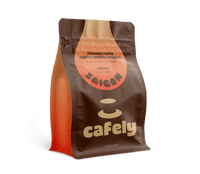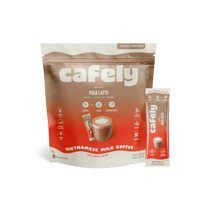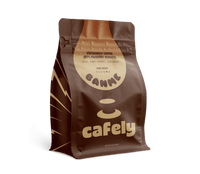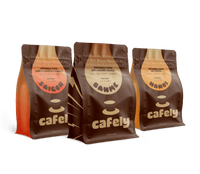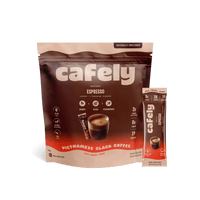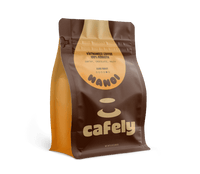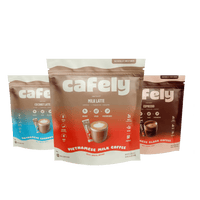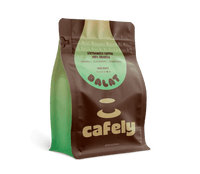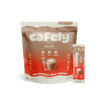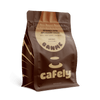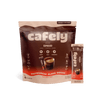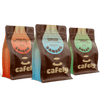Coffee jelly is a smooth, silky, jiggly dessert with a strong, bold coffee flavor. It can be made using your favorite coffee beans prepared with your favorite brewing method.
You can serve this jelly on its own, with ice cream, or as part of a larger dessert. You can also add coffee jelly cubes to milky iced coffee to add a boba-like element to the brew.
In this guide, you'll learn how to make a simple but delicious coffee jelly recipe using just four ingredients you may already have in your kitchen.
Coffee Jelly Recipe Summary
- Brew two cups of strong coffee.
- Activate the gelatin.
- Mix the gelatin, sugar, and coffee.
- Heat the ingredients over high heat.
- Pour into a shallow dish.
- Cool in the refrigerator for 7–8 hours.
- Slice the jelly into cubes.
Coffee Jelly: What You Need

Coffee jelly is simple. You only need a few ingredients to make this coffee jelly recipe, and you should have all the equipment you need in your kitchen already.
Here’s what you need to make coffee jelly:
Equipment
- Coffee Maker — You’ll need a coffee maker unless you use instant coffee. A French press, moka pot, espresso machine, drip coffee maker, or pour-over coffee will work.
- Saucepan — You’ll use this to combine and heat the ingredients of the jelly.
- Measuring Cups — You’ll need some measuring cups to measure the ingredients precisely.
- Shallow Pan — A shallow Pyrex dish is perfect for pouring and setting the jelly.
- Sharp Knife — A sharp knife will help you cut the set jelly perfectly.
Ingredients
- Freshly Brewed Coffee — You’ll need some freshly brewed coffee made from high-quality coffee beans or instant coffee.
- Unflavored Gelatin — Unflavored gelatin acts as a thickening agent. This will provide the bouncy, jiggly texture of the jelly.
- White Sugar — Use refined white sugar. This will sweeten the jelly without altering the texture or color.
- Hot Water — You’ll need a couple of tablespoons of freshly boiled water to dissolve the gelatin.
Coffee Recommendations
The type of coffee you use to make coffee jelly is up to your taste. Most people prefer the smooth, sweet flavors of arabica coffee. However, robusta coffee and blends also work if you prefer a stronger coffee taste.
We recommend brewing fresh coffee from high-quality whole beans if you want to make the best-tasting coffee jelly. However, you can make brews from pre-ground coffee or use a strong instant coffee to make jelly.
Here’s what different types of coffee offer in jelly:
- Arabica Coffee — A 100% arabica such as DaLat creates a smooth, sweet jelly with a mild coffee flavor.
- Robusta Coffee — A 100% robusta such as HaNoi creates a dark, bold, slightly bitter jelly with a strong caffeine hit.
- Arabica and Robusta Blend — Blends such as Saigon OG create jelly with a balanced flavor profile, offering the best of both arabica and robusta coffee.
- Instant Coffee — The flavor profile of instant coffee is much less complex than freshly brewed coffee. However, it’s convenient for making coffee jelly and saves a bit of time.
Step-by-Step Guide: How to Make Coffee Jelly
Coffee jelly is surprisingly easy to make. The preparation time for making coffee jelly is only around 15 minutes. However, it takes some time to set — up to eight hours in the refrigerator.
Here’s how to make coffee jelly in six simple steps:
1. Brew the Coffee
Brew two cups of strong coffee using any home brewer you have. The drip coffee maker, pour-over, French press, moka pot, and espresso machine can all be used to make coffee for jelly.
2. Activate the Gelatin
In a bowl, combine 0.25 ounces (7 g) of gelatin with two tablespoons of hot water. Stir to activate the gelatin.
3. Combine the Ingredients
In a saucepan, add the two cups of coffee, activated gelatin, and three tablespoons of white granulated sugar. Stir to combine.
4. Heat the Ingredients
Place the pan over high heat and bring to a boil. Stirring gently, boil the ingredients for one to two minutes.
After one to two minutes, remove the saucepan from the heat.
5. Pour and Set the Jelly
Pour the coffee jelly mixture into a shallow Pyrex dish — avoid using glass that isn't heat-treated, as it could crack.
Once you've poured the mixture, give the dish a few solid taps on the counter to remove any air bubbles.
Leave the jelly on the counter for 30 minutes or until it’s cool enough to refrigerate. Place the jelly in the fridge and leave it to set overnight (at least eight hours).
6. Slice and Enjoy
Once the coffee jelly has set, remove the pan from the fridge and slice the jelly into uniform cubes.
Enjoy the coffee as it is or combine it with ice cream. You can also add the jelly to milk or iced coffee for a chewy boba-like coffee beverage.
What Can You Add to Coffee Jelly: 4 Ideas

You don’t only have to make plain coffee jelly using the recipe above. There are several ingredients you can add to coffee jelly to adjust its flavor and qualities. You can change the flavor by adding coconut, chocolate, and even alcohol.
Here are four different ways you can customize coffee jelly with additional ingredients:
1. Espresso Martini Jelly
Want to make an alcoholic jelly shot with similar flavors to the popular espresso martini cocktail?
Simply replace one cup of coffee in the recipe above with kahlúa and vodka at a 1:2 ratio. You should also increase the strength of the coffee you brew by increasing the coffee-to-water ratio, the stronger brew will balance out the alcohol.
2. Coconut Coffee Jelly
Coconut coffee jelly combines the sweet, tropical flavors of coconut with the bold, dark flavors of coffee. We recommend robusta coffee for this jelly — its strong, nutty, slightly bitter notes pair well with coconut.
To make this coffee, simply replace one of the cups of coffee in the recipe above with coconut milk. Add a tablespoon or two of dedicated coconut flakes for texture if desired.
3. Mocha Coffee Jelly
Mocha coffee jelly is perfect for coffee and chocolate lovers. To make this jelly, simply add two tablespoons of cocoa powder to your coffee before following the coffee jelly recipe above.
4. Irish Coffee Jelly
Adding whiskey and a dash of powdered milk to coffee jelly can create a delightful alcoholic dessert. “Irish coffee jelly” combines the flavors of Irish whiskey, cream, and coffee that the cocktail is famous for.
Here's what you need to make Irish coffee jelly:
- Irish whiskey (Jameson or similar)
- Freshly brewed coffee
- Gelatin
- Milk powder
- White sugar
To make this jelly, combine the solid ingredients with the liquid ingredients in a ratio that suits your palate. Add one tablespoon of gelatin per cup of liquid and heat the mixture before pouring and setting in the fridge.
FAQs: How to Make Coffee Jelly
Do you want to learn more about making coffee jelly and other alternative ways to use coffee?
Head over to the Cafely Blog or check out the answers to the frequently asked questions below:
1. What is Coffee Jelly?

Coffee jelly is a sweet dessert made from coffee, gelatin, and sugar. This unique treat combines the bold flavors of coffee with the soft, jiggly texture of jelly. This dessert originates from Japan, but it has been gaining popularity in the West.
2. Can You Make Coffee Jelly Vegan?
Yes. You can make coffee jelly vegan by substituting the gelatin with a plant-based alternative. The best plant-based gelatin alternative is agar-agar powder — a seaweed-derived thickening agent.
3. Can You Add Alcohol to Coffee Jelly?
Yes, you can add alcohol to coffee jelly to create a delicious, adult-friendly dessert.
Alcohol pairs wonderfully with the rich, bold, dark flavors of coffee. Liqueurs like Kahlúa or Tia Maria enhance the coffee flavor, spirits like whiskey, rum, or brandy give a bold alcoholic kick, and dairy-based liqueurs like Baileys Irish Cream provide a smooth, creamy touch.
4. What Desserts Contain Coffee?
Coffee works wonderfully in several types of desserts. Its bold, rich, dark flavors and caffeine content make it the perfect ingredient for after-dinner sweet treats.
Here are some popular coffee desserts:
- Tiramisu
- Coffee Ice Cream
- Coffee Jelly
- Espresso Brownies
- Affogato
- Coffee Cake
- Mocha Cheesecake
- Coffee Macarons
- Coffee Mousse
5. Does Coffee Jelly Contain Caffeine?
Yes. Coffee jelly does contain caffeine unless it's made with decaffeinated coffee. The exact amount of caffeine depends on the type and amount of coffee used in the recipe. A typical serving of coffee jelly made with arabica coffee contains somewhere between 40 mg and 100 mg of caffeine, while those made with decaf has around 2 mg. Even when made with decaf, though, a small amount of caffeine remains since the decaffeination process can’t remove it completely.
6. What’s the Best Coffee for Coffee Jelly?
The best coffee for coffee jelly depends on your flavor preference, as it's the key ingredient in the dessert. Most people prefer the naturally sweet, smooth, nutty flavors of 100% arabica coffee. Some prefer the bold, dark, smoky flavors of 100% robusta coffee. Others enjoy the balance between arabica and robusta — opting for a blend instead.
7. Can You Use Espresso to Make Coffee Jelly?
Yes. You can use espresso coffee to make coffee jelly. Espresso is an excellent choice if you want to make jelly with a more concentrated and intense coffee flavor. Espresso jelly also has a higher caffeine content due to the high (1:2) coffee-to-water ratio of espresso.
8. Can You Use Instant Coffee to Make Jelly?
Yes. You can use instant coffee to make coffee jelly. It won't have the same charismatic flavor as jelly made with freshly brewed coffee, but it is simpler. Instant coffee is convenient for making coffee jelly. Its dissolvable format provides ultimate control over the strength of the brew and the amount of water needed to make the jelly.
9. How Do You Make Coffee Syrup for Desserts?
Coffee syrup can be used to make iced coffee, flavor cocktails, and garnish desserts. It’s simple to make. All you need to do is brew one cup of concentrated coffee and combine it with two cups of granulated sugar. Heat the mixture over low heat, stirring constantly. Once the syrup has formed, remove it from the heat, cool it, and store it in the refrigerator.
10. How Do You Make Iced Coffee at Home?
Iced coffee is easy to make at home, and it makes the perfect dessert drink. The basic process involves brewing a strong, concentrated shot of coffee before sweetening it with sugar or syrup, cooling it, pouring it over ice, and diluting it with milk.
